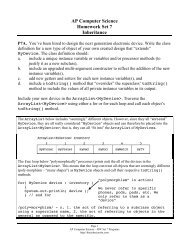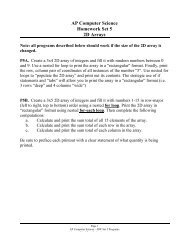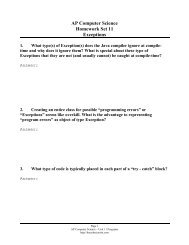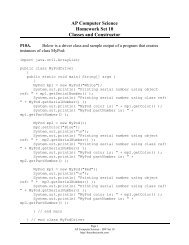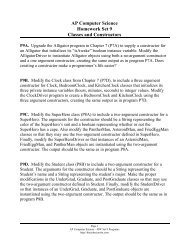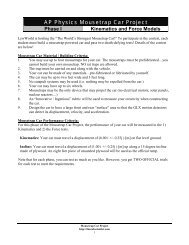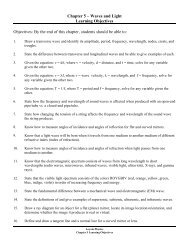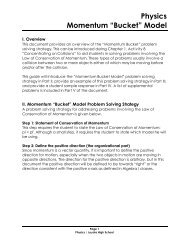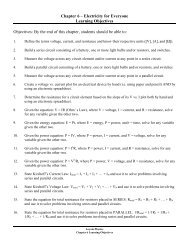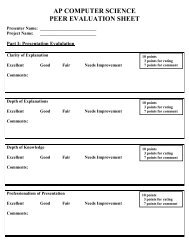HW Set 2 - thecubscientist.com
HW Set 2 - thecubscientist.com
HW Set 2 - thecubscientist.com
Create successful ePaper yourself
Turn your PDF publications into a flip-book with our unique Google optimized e-Paper software.
AP Computer Science<br />
Homework <strong>Set</strong> 2<br />
Class Design<br />
P2A. Write a class Song that stores information about a song. Class Song should<br />
include at least three instance variables that represent characteristics of the song.<br />
Include a zero-argument and three-argument constructor to initialize all instance<br />
variables. It should also have a toString() method to display the object’s instance<br />
variables in a user-friendly format.<br />
Write a separate “SongDriver” class to:<br />
a) create an instance of a Song called “song1” using its zero-argument<br />
constructor,<br />
b) display the instance variables of the “song1” using the object’s<br />
toString() method,<br />
c) create an instance of a Song called a “song2” and initialize its instance<br />
variables using the object’s multi-argument constructor, and<br />
d) display the instance variables of the “song2” using the object’s<br />
toString() method.<br />
Page 1<br />
AP Computer Science – <strong>HW</strong> <strong>Set</strong> 2 Programs<br />
http://<strong>thecubscientist</strong>.<strong>com</strong>
P2B. Write a class Clock that stores information about a clock. It should have<br />
integer instance variables for the Clock’s hours, minutes, seconds. Include a zeroargument<br />
and three-argument constructor to initialize all instance variables. It should<br />
also have a toString() method to display the time in the format shown below:<br />
The time is 3:45:16<br />
Note that zero-argument constructors should initialize instance variables to known<br />
values, most <strong>com</strong>monly zero for integers, “” for Strings, or false for boolean values.<br />
See the example below:<br />
public Clock()<br />
{<br />
int hour = 0;<br />
double cost = 0.0;<br />
String brand = new String(“”);<br />
boolean isOn = false;<br />
} // end constructor Clock<br />
Write a separate “ClockDriver” class to:<br />
a) create an instance of a Clock called “kitchenClock” using its zeroargument<br />
constructor,<br />
b) display the time of the “kitchenClock” using its toString() method,<br />
c) create an instance of a Clock called a “bedroomClock” and set the hours,<br />
minutes, and seconds using the Clock’s three-arguments constructor using a<br />
JOptionPane, and<br />
d) display the time of the “bedroomClock” using its toString() method.<br />
Page 2<br />
AP Computer Science – <strong>HW</strong> <strong>Set</strong> 2 Programs<br />
http://<strong>thecubscientist</strong>.<strong>com</strong>
P2C. Let’s write another class and test it with a driver. This time let’s create a<br />
Student class that models a Loyola student. The Student class should have<br />
instance variables for the student’s first and last name, and at least TWO other<br />
instance variables chosen by you. Include a zero-argument and multi-argument<br />
constructor to initialize all instance variables. Choose the most appropriate variable<br />
types (i.e. int, double, String, boolean) for each instance variable. It should also have<br />
a toString() method to display the object’s instance variables in a user-friendly<br />
format.<br />
Write a separate “StudentDriver” class to:<br />
a) create an instance of a Student called “senior001” using its zeroargument<br />
constructor,<br />
b) display the instance variables of the “senior001” using the object’s<br />
toString() method,<br />
c) create an instance of a Student called a “frosh001” and initialize its instance<br />
variables using the object’s multi-argument constructor, and<br />
d) display the instance variables of the “frosh001” using the object’s<br />
toString() method.<br />
If you are looking for an extra challenge, try to printout the results of the program<br />
using JOptionPane.showMessageDialog(). See the LewTube video for this<br />
<strong>HW</strong> <strong>Set</strong> on the details of how to use this very cool tool (no rhyme intended.)<br />
P2D. Design a class that models an object of your choice (e.g. type of car, sports<br />
team, musical instrument, etc.) Include at least two different instance variables of two<br />
different types (e.g. String and an int, int and a double, boolean and a String, etc.) for<br />
your class. It should also have a toString() method to display the object’ instance<br />
variables in a user-friendly format.<br />
Write a separate “YourObjectDriver” class to:<br />
a) create an instance of a your object called “obj1” (or a name more appropriate<br />
for your object) using its zero-argument constructor,<br />
b) display the instance variables of the “obj1” using the object’s toString()<br />
method,<br />
c) create an instance of a your object called a “obj2” and initialize its instance<br />
variables using the object’s multi-argument constructor, and<br />
d) display the instance variables of the “obj2” using the object’s toString()<br />
method.<br />
Page 3<br />
AP Computer Science – <strong>HW</strong> <strong>Set</strong> 2 Programs<br />
http://<strong>thecubscientist</strong>.<strong>com</strong>
P2E. Blackjack! Design a class called “Card” that models a playing card. Decide<br />
what instance variables you will need for your class in order to play Blackjack (or<br />
any other card game.) Include a zero-argument constructor and the appropriate multiargument<br />
constructor for your class. It should also have a toString() method to<br />
display ALL of the object’s instance variables in a user-friendly format…this can be<br />
a bit tricky…<br />
Write a CardDriver that will perform the following tasks:<br />
a) Create three Card objects: a blank card (i.e. a Card created using its zeroargument<br />
constructor), a “number” card, and a “face” card…you pick the<br />
cards.<br />
b) Create an array called “myHand” that can hold 3 Card objects.<br />
Below are the lines of code that demonstrate how to create an array of Card objects<br />
and how to place a Card object into an array called myHand.<br />
Card[] myHand = new Card[10];<br />
Card card1 = new Card( 10, “Jack”, “Hearts” );<br />
myHand[0] = card1;<br />
c) Use a for loop to traverse the array of your Cards and print each Card using<br />
System.out.println().<br />
The following programs DO NOT need a separate class and driver files. They<br />
are stand-alone programs that are meant to review previous topics (and<br />
introduce a couple of new non-class concepts)<br />
P2F. Write a program that creates an array that can hold 9 double values that<br />
represent baseball batting averages for a starting baseball lineup. Use a for loop to<br />
populate array with double values in the range of 0.00 to 0.500. Recall that “double”<br />
values are what Java calls “real” numbers. Use a second for loop to print the values in<br />
the array with one number per line. Finally, use a third for loop to traverse the array<br />
and find and print the maximum batting average in the array. See the LewTube for<br />
this <strong>HW</strong> assignment to see how to control the precision of a double number when you<br />
print it.<br />
Page 4<br />
AP Computer Science – <strong>HW</strong> <strong>Set</strong> 2 Programs<br />
http://<strong>thecubscientist</strong>.<strong>com</strong>
P2G. College application time! Write a program that creates an array of Strings. Fill<br />
the array with the name of the universities that you will be applying to. Then perform<br />
the following tasks:<br />
a. traverse the array using a for loop and printout the length of each university’s<br />
name.<br />
You can find the length of a String as shown below:<br />
String name = new String( “UCLA” );<br />
System.out.println( name.length() ); // prints “4”<br />
b. print the name of the university that has the shortest length.<br />
c. You’ve decided not to apply to one of the schools on your list. Remove that<br />
school from the list by setting that element in the array to “null”. This can be<br />
done as shown below:<br />
school[3] = new String( “NYU” );<br />
school[3] = null; // null “removes” NYU from array<br />
d. print your list of schools again using a second for loop.<br />
P2H. Let’s upgrade out “Login” program from <strong>HW</strong> <strong>Set</strong> 1 so that it will allows the<br />
user to input a username/password <strong>com</strong>bination for a total of three attempts. If<br />
incorrect on the fourth attempt, the program should print out the following message:<br />
“You have exceeded your three attempts.<br />
Please try again next period.”<br />
Hint: Use a loop along with a counter to count the number of unsuccessful attempts.<br />
By the end of the lesson students should be able to:<br />
a. Write the Java code define a class, its data members, and its constructors.<br />
b. Write a toString() method for a class.<br />
c. Write the Java code that uses the “new” operator to instantiate an object.<br />
d. Write the Java code for a “driver” class that creates instance of an object and<br />
initializes the class’ instance variables and calls the class’ toString()<br />
method.<br />
Page 5<br />
AP Computer Science – <strong>HW</strong> <strong>Set</strong> 2 Programs<br />
http://<strong>thecubscientist</strong>.<strong>com</strong>




